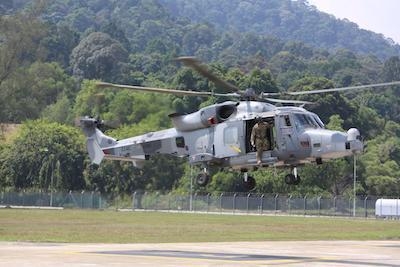Mon, Apr 23, 2018
Aircraft Already In Service With The Republic Of Korea Navy And Will Enter Service With The Philippine Navy In 2019
Leonardo, with the support of the UK’s 847 Naval Air Squadron, presented its AW159 Wildcat helicopter to Malaysia’s Armed Forces at Royal Malaysian Navy Base Lumut and Leonardo Helicopters’ facility at Subang Airport, near Kuala Lumpur last week. The two AW159 Wildcats are part of the French Navy’s five month amphibious deployment, Exercise Jeanne d’Arc, to the Middle East, Asia and South Pacific and are embarked on the helicopter assault ship FS Dixmude to provide a battlefield reconnaissance capability to the deployed forces.

The AW159 has a semi-rigid rotor head which gives it high agility and the same legendary ship operating capabilities of the Lynx helicopter. It is also fitted with composite rotor blades utilising the same technology that enabled the Lynx to break the world helicopter speed record. The AW159 is powered by a pair of LHTEC CTS800-4N engines, each providing up to 1,361 shp, which gives the aircraft exceptional performance, even in hot and high environments.
The AW159 has the most modern integrated cockpit of any naval helicopter, featuring four large area (10” x 8”) cockpit displays and a fully integrated avionics suite and mission system to provide increased mission capability and increased crew effectiveness. The key sensors integrated into the AW159 include the Leonardo Seaspray 7000E series Active Electronically-Scanned Array (AESA) radar, a dipping sonar system, electro-optical device and Leonardo electronic warfare systems. A range of weapons can be carried, including torpedoes and air-to-surface missiles, on its weapon carriers.
The UK’s Royal Navy and British Army operate 62 AW159 Wildcats in both naval and over land roles including ASuW, ASW, maritime surveillance and battlefield reconnaissance, while the Republic of Korea Navy operate eight AW159 helicopters in ASW and ASuW roles. The Philippine Navy has also ordered two AW159s that will be delivered next year. The Royal Malaysian Navy currently operates the Leonardo Super Lynx 300 helicopter in the Anti-submarine warfare (ASW) and anti-surface warfare (ASuW) roles.
847 Naval Air Squadron is part of the UK’s Commando Helicopter Force based at Royal Navy Air Station Yeovilton and operate the Army variant of the AW159 Wildcat. The British Army’s variant of the AW159 Wildcat is almost identical to the Royal Navy variant with the only major equipment differences being the Army aircraft do not have the Seaspray 7000E series AESA radar or weapon carriers.
(Image provided with Leonardo Company news release)
More News
Aero Linx: Model Aeronautical Association of Australia MAAA clubs are about fun flying, camaraderie and community. For over 75 years, the MAAA has been Australia’s largest fl>[...]
Touchdown Zone Lighting Two rows of transverse light bars located symmetrically about the runway centerline normally at 100 foot intervals. The basic system extends 3,000 feet alon>[...]
“Discovery and innovation are central to our mission at Virgin Galactic. We’re excited to build on our successful record of facilitating scientific experiments in subor>[...]
How To Get A Story On Aero-TV News/Feature Programming How do I submit a story idea or lead to Aero-TV? If you would like to submit a story idea or lead, please contact Jim Campbel>[...]
Student Pilot Reported That During Rotation, “All Of A Sudden The Back Of The Plane Kicked To The Right..." Analysis: The student pilot reported that during rotation, “>[...]
 ANN's Daily Aero-Linx (05.02.24)
ANN's Daily Aero-Linx (05.02.24) ANN's Daily Aero-Term (05.02.24): Touchdown Zone Lighting
ANN's Daily Aero-Term (05.02.24): Touchdown Zone Lighting Aero-News: Quote of the Day (05.02.24)
Aero-News: Quote of the Day (05.02.24) ANN FAQ: Contributing To Aero-TV
ANN FAQ: Contributing To Aero-TV NTSB Final Report: Cirrus Design Corp SR20
NTSB Final Report: Cirrus Design Corp SR20



